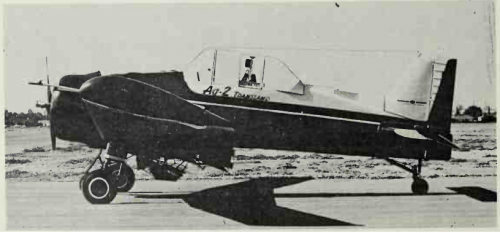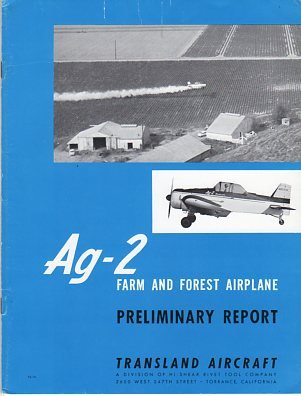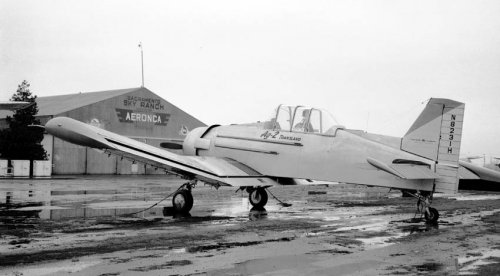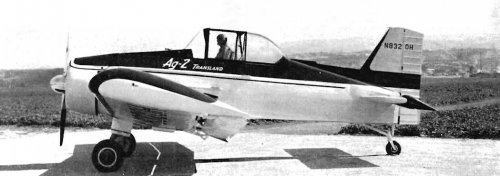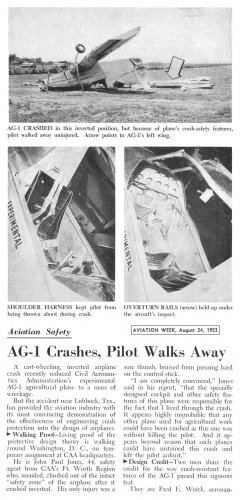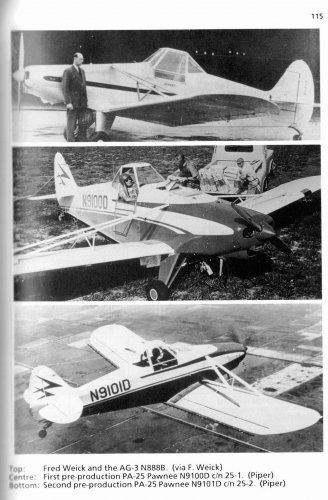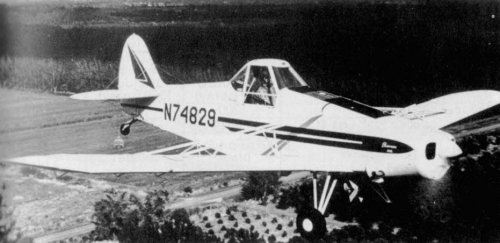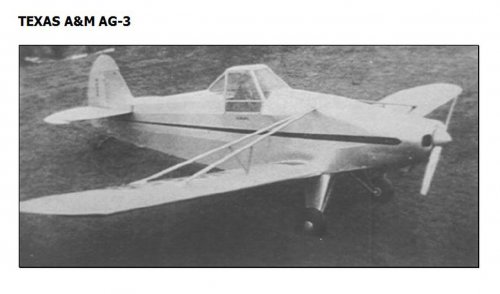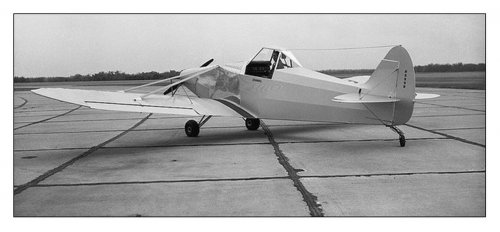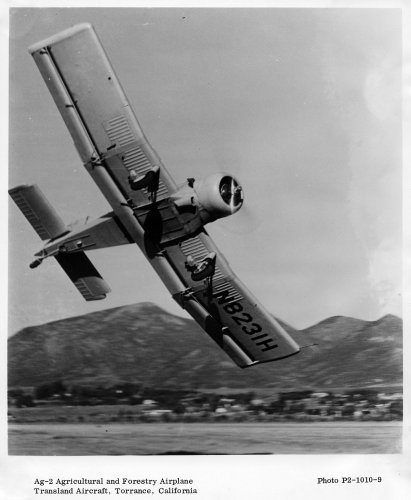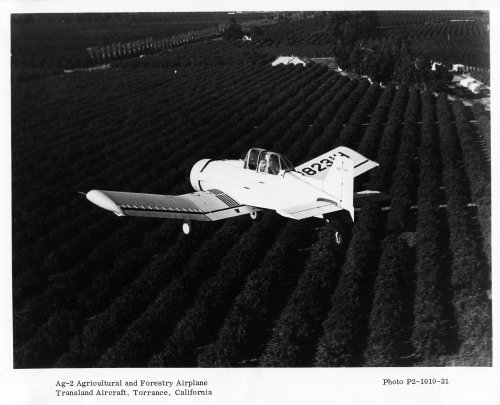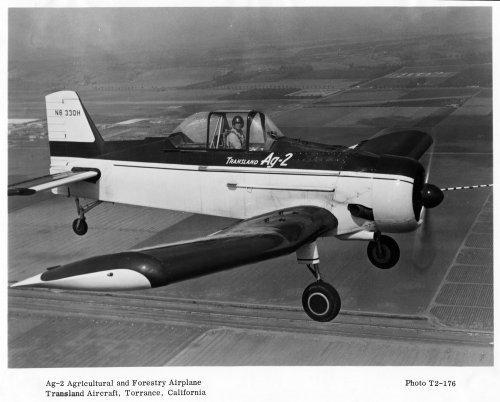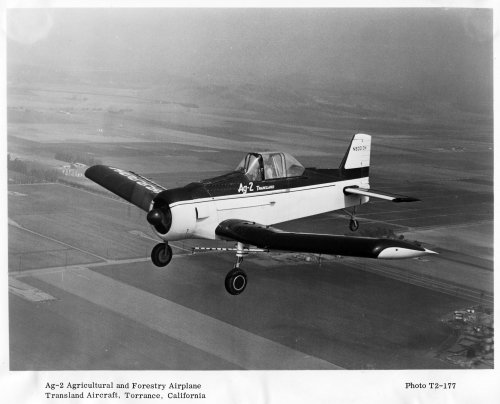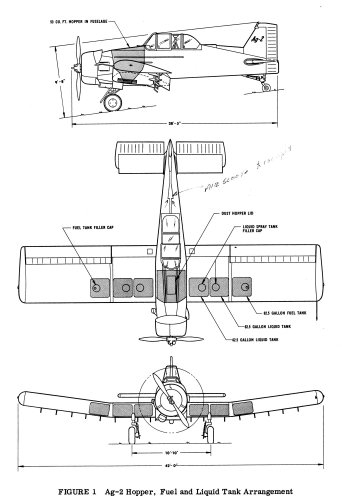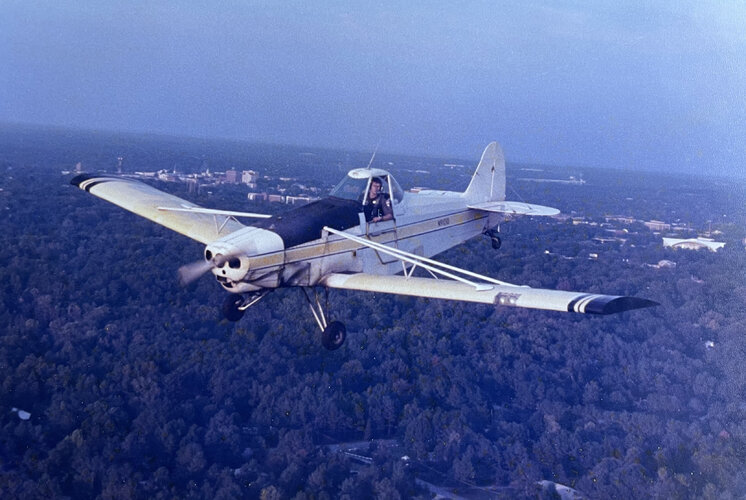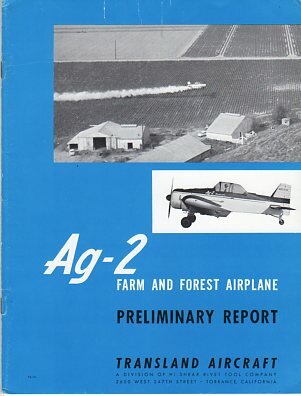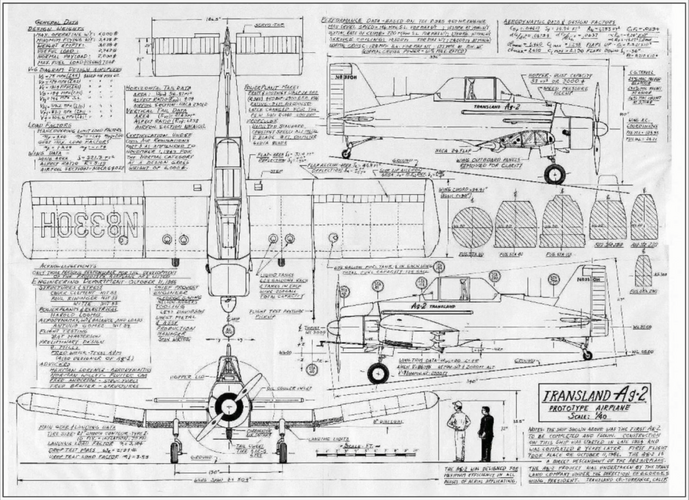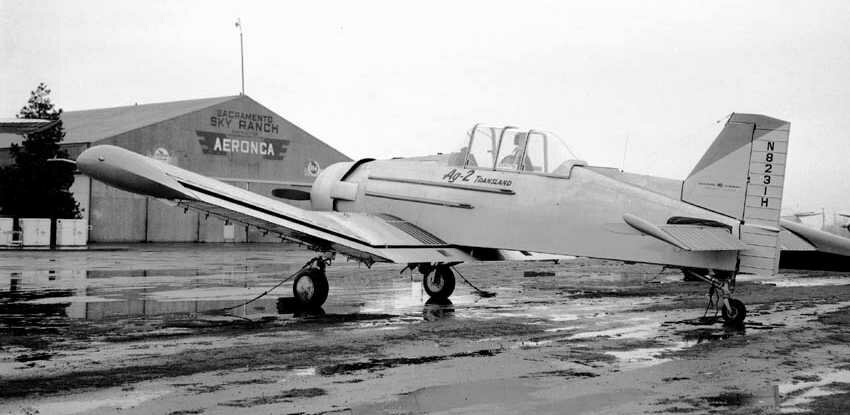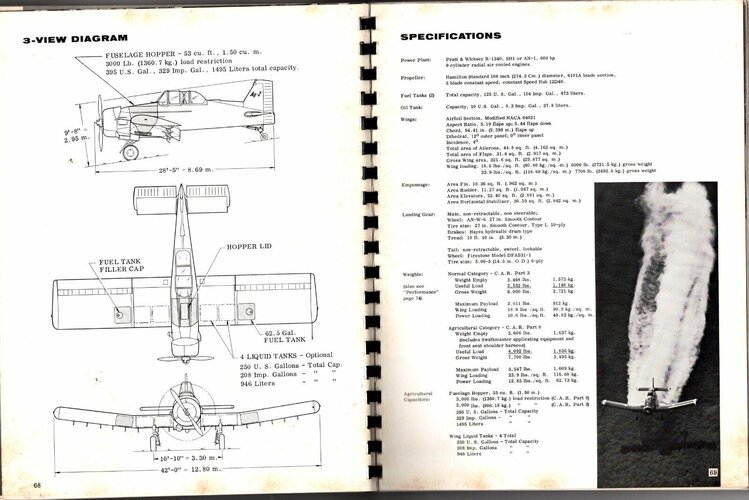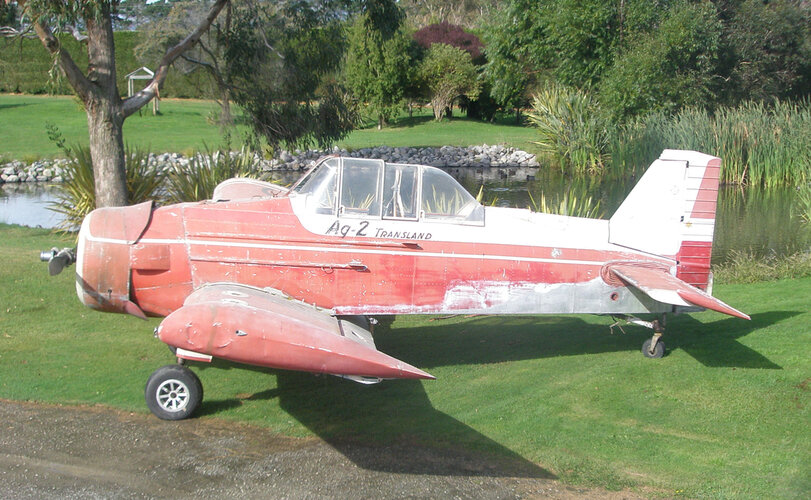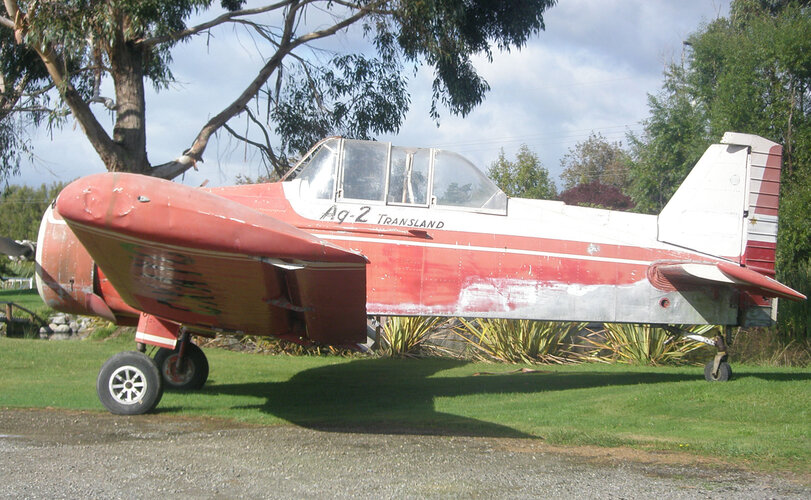- Joined
- 28 January 2008
- Messages
- 635
- Reaction score
- 511
This was originally going to go into the category “All those weird and wonderful postwar U.S. one-offs...” but when I discovered the prototype was re-engined and three examples flew it lost its one-off uniqueness!
Transland Ag-2
The Transland Company of California, U.S.A., had for many years been converting surplus World War II aircraft into crop-dusters. A crop duster had been developed by Texas A&M College and designated the Ag-1.
This led to the development in conjunction with the Texas A. & M. College and Transland designer George Roth of a new type. The prototype of a single-seat agricultural aircraft was built by Transland Aircraft, a division of the Hi-Shear Corp. Construction of the first aircraft began in 1954 and the Transland Ag-2 made its first flight from Torrance as N8330H on 11 October 1956. The parent company hoped to put aircraft into production for all types of aerial spraying and as a tanker for fire-fighting and control. In the event only three examples were completed. Although considered by many as ahead of its time, it was too expensive in the 1950's when there was still a surplus of cheap ex-World War II examples available for agricultural work with spares readily available.
Powered initially by a Pratt & Whitney R-985 (450 hp) engine. To increase its payload capacity to 3,000 lb (1,360 kg), it was later re-engined with a Pratt & Whitney R-1340 S3H-1 (600 hp) powerplant. This also allowed for the aircraft to become a two seat machine with the rear cockpit modified to carry a passenger. The payload was increased from 2,000 lbs to 3,000 lbs, giving an all-up weight in the agricultural category of 7,700 lbs. The Civil Aeronautics Administration awarded Type Certificate #4A20 (FAA Pt 3 Type Approval ) to Transland Aircraft for the Ag-2 on 24 June 1958. Potential customers were also offered the option of a Pratt & Whitney AN-1 Wasp 9-cylinder radial. The aircraft used Hamilton Standard 6101A two-bladed constant speed propeller.
The AG-2 utilised equipment of a specialised nature which included rotary hopper gates, agitators and pumps. Two complete and separate dispersion systems were built into the airframe, one to deal with fluids and the other with powders. It used the Transland Boom-Master pump and liquid system with a swath width of 80 to 100 ft (24 to 30 m) and a Transland developed dry materials dispensing system.
The fuselage was an all-metal semi-monocoque structure of riveted 24ST aluminium alloy. all of the internal fuselage was primed with zinc-chromate and all other surfaces were protected against the corrosive agricultural chemicals carried.
The Ag-2 had a cantilever low-wing with NACA 64021 high lift wing section. The wings were all-metal made of a riveted aluminium alloy similar to the fuselage. Full-span slotted flaps, the outer wing flaps with slot lips which served as ailerons. When the flaps were lowered, elevators are automatically trimmed. The Ag-2 had a dihedral 0 degrees (centre-section) and 12 degrees (outer panels). The wing incidence was 4 degrees.
The tail unit was a cantilever all-metal structure. the undercarriage was fixed and had a tail-wheel. Vultee supplied the shock-struts. Attached to the shock-struts were wire-cutting blades as a lot of the flight time was to be at low-level. Goodrich provided the wheels and 27SC tyres as well as a suitable low-pressure non-steering tail wheel. The aircraft carried two fuel tanks, one in each wing.
While the test flying was done on the first aircraft, a second, N8331H, was built and fitted with the P&W R-1340. This example first flew from Torrance in June 1958.
In 1959, a third and final aircraft, N8232H, was built and operated in Panama.
N8330H , the prototype was sold in Uruguay in 1962 and registered CX-AYC in May 1962. Operated by Azucarera del Litorial SA of Paysandu, it flew sugar fertilizing operations until late 1963, when it was stored. After many years in storage, it was flown again on 1991 and flew until 1993 when it was parked. In April 2003 the aircraft arrived in New Zealand for restoration, with 1091 flying hours recorded. See also http://rnzaf.proboards.com/thread/18119/unbelievable-zlin-topdresser-build?page=3 .
Details (Prototype R-985)
Engine: 1 x Pratt & Whitney R-985 (450 hp)
Seats: 1
Wing span: 42 ft 0 in
Length: 27 ft. 11 in
Height: 9 ft . 8 in.
Wing area: 321.6 sq ft
Payload weight: 2,000 lb
Hopper cap: 53 cubic feet
Load cap: 2,000 lbs
Spray tank cap: 250 USG
Fuel tank: 2 x 62.5 US gal
Oil tank: 10 US gal
Wing aspect ratio (flaps up): 5.19
Wing aspect ratio (flaps down): 5.44
Constant chord: 7 ft 10.4 in (2.40 m) with flaps up
Details (R-1340)
Engine: 1 x Pratt & Whitney R-1340 (600 hp)
Seats: 2
Wing span: 42 ft 0 in
Length: 27 ft. 11 in
Height: 9 ft . 8 in.
Wing area: 321.6 sq ft
Payload weight: 3,000 lb (1,360 kg)
Maximum weight: 7,700 lb
Empty weight: 3,468 lb
Propeller diameter: 9 ft 0 in (2.74 m)
Wing aspect ratio (flaps up): 5.19
Wing aspect ratio (flaps down): 5.44
Constant chord: 7 ft 10.4 in (2.40 m) with flaps up
Sources
Jane's All the World's Aircraft 1952-53 (Sampson, Low) editor Leonard Bridgman
Jane's All the World's Aircraft 1965-66 (Janes) editor J.W.R. Taylor
Air Pictorial 1957-03
A report brochure for the Ag-2 is advertised for sale at http://www.barbarossabooks.com
Transland Ag-2
The Transland Company of California, U.S.A., had for many years been converting surplus World War II aircraft into crop-dusters. A crop duster had been developed by Texas A&M College and designated the Ag-1.
This led to the development in conjunction with the Texas A. & M. College and Transland designer George Roth of a new type. The prototype of a single-seat agricultural aircraft was built by Transland Aircraft, a division of the Hi-Shear Corp. Construction of the first aircraft began in 1954 and the Transland Ag-2 made its first flight from Torrance as N8330H on 11 October 1956. The parent company hoped to put aircraft into production for all types of aerial spraying and as a tanker for fire-fighting and control. In the event only three examples were completed. Although considered by many as ahead of its time, it was too expensive in the 1950's when there was still a surplus of cheap ex-World War II examples available for agricultural work with spares readily available.
Powered initially by a Pratt & Whitney R-985 (450 hp) engine. To increase its payload capacity to 3,000 lb (1,360 kg), it was later re-engined with a Pratt & Whitney R-1340 S3H-1 (600 hp) powerplant. This also allowed for the aircraft to become a two seat machine with the rear cockpit modified to carry a passenger. The payload was increased from 2,000 lbs to 3,000 lbs, giving an all-up weight in the agricultural category of 7,700 lbs. The Civil Aeronautics Administration awarded Type Certificate #4A20 (FAA Pt 3 Type Approval ) to Transland Aircraft for the Ag-2 on 24 June 1958. Potential customers were also offered the option of a Pratt & Whitney AN-1 Wasp 9-cylinder radial. The aircraft used Hamilton Standard 6101A two-bladed constant speed propeller.
The AG-2 utilised equipment of a specialised nature which included rotary hopper gates, agitators and pumps. Two complete and separate dispersion systems were built into the airframe, one to deal with fluids and the other with powders. It used the Transland Boom-Master pump and liquid system with a swath width of 80 to 100 ft (24 to 30 m) and a Transland developed dry materials dispensing system.
The fuselage was an all-metal semi-monocoque structure of riveted 24ST aluminium alloy. all of the internal fuselage was primed with zinc-chromate and all other surfaces were protected against the corrosive agricultural chemicals carried.
The Ag-2 had a cantilever low-wing with NACA 64021 high lift wing section. The wings were all-metal made of a riveted aluminium alloy similar to the fuselage. Full-span slotted flaps, the outer wing flaps with slot lips which served as ailerons. When the flaps were lowered, elevators are automatically trimmed. The Ag-2 had a dihedral 0 degrees (centre-section) and 12 degrees (outer panels). The wing incidence was 4 degrees.
The tail unit was a cantilever all-metal structure. the undercarriage was fixed and had a tail-wheel. Vultee supplied the shock-struts. Attached to the shock-struts were wire-cutting blades as a lot of the flight time was to be at low-level. Goodrich provided the wheels and 27SC tyres as well as a suitable low-pressure non-steering tail wheel. The aircraft carried two fuel tanks, one in each wing.
While the test flying was done on the first aircraft, a second, N8331H, was built and fitted with the P&W R-1340. This example first flew from Torrance in June 1958.
In 1959, a third and final aircraft, N8232H, was built and operated in Panama.
N8330H , the prototype was sold in Uruguay in 1962 and registered CX-AYC in May 1962. Operated by Azucarera del Litorial SA of Paysandu, it flew sugar fertilizing operations until late 1963, when it was stored. After many years in storage, it was flown again on 1991 and flew until 1993 when it was parked. In April 2003 the aircraft arrived in New Zealand for restoration, with 1091 flying hours recorded. See also http://rnzaf.proboards.com/thread/18119/unbelievable-zlin-topdresser-build?page=3 .
Details (Prototype R-985)
Engine: 1 x Pratt & Whitney R-985 (450 hp)
Seats: 1
Wing span: 42 ft 0 in
Length: 27 ft. 11 in
Height: 9 ft . 8 in.
Wing area: 321.6 sq ft
Payload weight: 2,000 lb
Hopper cap: 53 cubic feet
Load cap: 2,000 lbs
Spray tank cap: 250 USG
Fuel tank: 2 x 62.5 US gal
Oil tank: 10 US gal
Wing aspect ratio (flaps up): 5.19
Wing aspect ratio (flaps down): 5.44
Constant chord: 7 ft 10.4 in (2.40 m) with flaps up
Details (R-1340)
Engine: 1 x Pratt & Whitney R-1340 (600 hp)
Seats: 2
Wing span: 42 ft 0 in
Length: 27 ft. 11 in
Height: 9 ft . 8 in.
Wing area: 321.6 sq ft
Payload weight: 3,000 lb (1,360 kg)
Maximum weight: 7,700 lb
Empty weight: 3,468 lb
Propeller diameter: 9 ft 0 in (2.74 m)
Wing aspect ratio (flaps up): 5.19
Wing aspect ratio (flaps down): 5.44
Constant chord: 7 ft 10.4 in (2.40 m) with flaps up
Sources
Jane's All the World's Aircraft 1952-53 (Sampson, Low) editor Leonard Bridgman
Jane's All the World's Aircraft 1965-66 (Janes) editor J.W.R. Taylor
Air Pictorial 1957-03
A report brochure for the Ag-2 is advertised for sale at http://www.barbarossabooks.com

